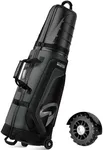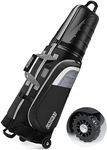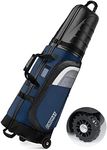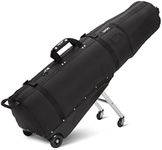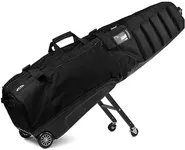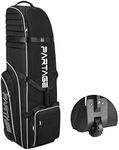Buying Guide for the Best Golf Travel Bags
Choosing the right golf travel bag is essential for protecting your clubs and making your travel experience smoother. The best bag for you will depend on how often you travel, the type of transportation you use, and your personal preferences for convenience and protection. Understanding the key features will help you make a choice that keeps your equipment safe and makes your journey easier.Bag Type (Hard Case vs. Soft Case)The type of golf travel bag refers to whether it is a hard case or a soft case. Hard cases are made from rigid materials and offer maximum protection for your clubs, making them ideal for air travel or rough handling. Soft cases are lighter and easier to store when not in use, but they may offer less protection. If you travel frequently by plane or want the highest level of protection, a hard case is a good choice. If you mostly travel by car or need something lightweight and easy to carry, a soft case may be more suitable.
Padding and ProtectionPadding refers to the cushioning inside the bag that protects your clubs from impacts. More padding means better protection, especially for the club heads. Some bags have extra padding at the top where clubs are most vulnerable. If you are concerned about your clubs getting damaged during travel, look for a bag with thick, well-placed padding. If you only travel occasionally or handle your own bag most of the time, moderate padding may be sufficient.
Size and CapacitySize and capacity determine how many clubs and accessories you can fit in the bag. Some bags are designed for standard sets, while others can accommodate extra clubs, shoes, and gear. Make sure the bag is large enough for your golf set and any extras you want to bring. If you have a larger or non-standard set, check the dimensions carefully. For most users, a standard size will be enough, but if you like to pack extra items, look for a bag with more space.
WeightThe weight of the bag affects how easy it is to carry and transport. Lighter bags are easier to handle, especially if you have to move them through airports or load them into cars. However, lighter bags may offer less protection. If you prioritize ease of movement and don’t need maximum protection, a lighter bag is a good choice. If you want the most protection and don’t mind a heavier bag, a sturdier option may be better.
Wheels and HandlesWheels and handles make it easier to move your golf travel bag, especially in airports or over long distances. Some bags have two wheels, while others have four for better maneuverability. Handles should be sturdy and comfortable to grip. If you expect to walk long distances with your bag or navigate busy airports, look for a bag with smooth-rolling wheels and multiple handles for easy lifting and pulling.
Security FeaturesSecurity features include lockable zippers, reinforced closures, and straps to keep your clubs secure inside the bag. These features help prevent theft and keep your equipment from shifting during travel. If you are concerned about security or will be checking your bag on flights, look for bags with built-in locks or the ability to add your own. For less risky travel, basic closures may be sufficient.
Storage PocketsStorage pockets allow you to carry extra items like shoes, balls, tees, and clothing. More pockets mean more organization and convenience. If you like to keep your gear organized or bring extra accessories, look for a bag with multiple, well-placed pockets. If you prefer to travel light, fewer pockets may be fine.
Durability and MaterialDurability depends on the materials used in the bag’s construction. Stronger materials like reinforced nylon or hard plastics last longer and protect better against wear and tear. If you travel often or want a bag that will last for many trips, choose one made from high-quality, durable materials. For occasional use, a less rugged material may be acceptable.
